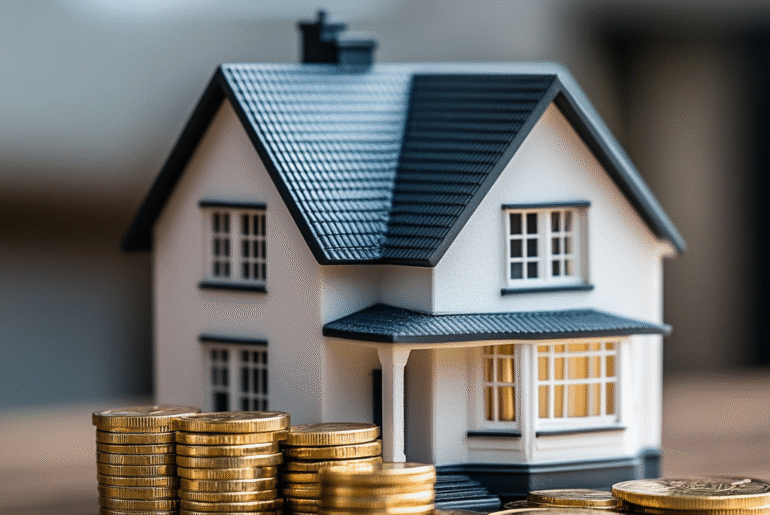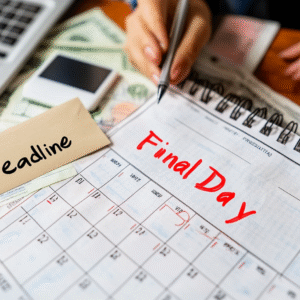This article may contain references to products or services from one or more of our advertisers or partners. We may receive compensation when you click on links to those products or services. Nonetheless, our opinions are our own.
The information presented in this article is accurate to the best of our knowledge at the time of publication. However, information is subject to change, and no guarantees are made about the continued accuracy or completeness of this content after its publication date.
One of the hardest things about buying a house is coming up with the down payment. Different percentages have been mentioned, such as 20%, 10%, or even as low as 3%. But what do those numbers really mean for you and your financial readiness? If this is your first time buying a home, figuring out how to make a down payment can be challenging. We’ll explain everything you need to know in this article so you can choose a down payment that works for you and help you take the next step toward making your dream of owning a home come true.
Let’s look at the things that affect how much you should put down, the pros and cons of each option, and the best ways to reach your goal. With the right information, you’ll be well on your way to getting into your new home.
- The Importance of a Down Payment in Your Home Purchase Journey
- Calculating the Down Payment Percentage Based on Home Prices
- Exploring Different Financing Options Beyond the Traditional 20 Percent
- Strategies to Save for Your Down Payment Without Sacrificing Your Lifestyle
- Navigating Down Payment Assistance Programs That Could Help You
- Preparing for Additional Costs Beyond the Down Payment
- Conclusion: Set Yourself Up for Success
- Frequently Asked Questions
- Recommended Reads
The Importance of a Down Payment in Your Home Purchase Journey
It’s important to know what a down payment is and how it works when you start your journey to homeownership. This first investment not only affects the total cost of your mortgage, but it also has a big impact on getting good loan terms. A bigger down payment can lower your monthly payments and help you avoid expensive private mortgage insurance (PMI), which will help you save the most money in the long run. Here are several aspects to consider:
- Equity buildup: Your down payment directly contributes to your home equity, giving you a financial cushion and making it easier to refinance or sell in the future.
- Interest rates: Lenders often offer lower interest rates for borrowers who put down higher percentages, leading to lower overall borrowing costs.
- Loan options: A substantial down payment may qualify you for more mortgage programs, expanding your choices and potentially minimizing restrictions.
To help you understand different down payment options, take a look at the table below, which outlines common percentages and their associated benefits:
| Down Payment Percentage | Benefits |
|---|---|
| 3% – 5% | Lower initial investment; possible eligibility for first-time buyer programs |
| 10% – 15% | Reduces monthly payments; may avoid PMI |
| 20% or more | No PMI; better interest rates and increased equity |
You can make the process of buying a home easier by carefully thinking about how much you can afford to put down. It’s not just about getting a mortgage; it’s about planning for your future financially.
Calculating the Down Payment Percentage Based on Home Prices
It’s important to know how to figure out the down payment percentage on your future home. This percentage varies with the home’s price and the loan type. For example, if you want to put down 20% on a $300,000 home, you’ll need to multiply the price by 0.20. In other words, you’ll need to save $60,000 just for the down payment.
Here’s a simple table to visualize how down payment percentages scale with different home prices:
| Home Price | Down Payment (10%) | Down Payment (20%) |
|---|---|---|
| $200,000 | $20,000 | $40,000 |
| $300,000 | $30,000 | $60,000 |
| $400,000 | $40,000 | $80,000 |
A lot of first-time buyers put down less than 20% of the purchase price. This can lower the initial costs, but it may also mean they have to pay for private mortgage insurance. When deciding on the right percentage, always think about your budget, your financing options, and your long-term financial goals. It’s not just about getting a house; it’s also about being financially secure in the long run.
Exploring Different Financing Options Beyond the Traditional 20 Percent
The traditional benchmark of a 20% down payment can feel daunting. There are several financing options that can help you move forward with greater flexibility:
- FHA Loans: Backed by the Federal Housing Administration, these loans allow you to put down as little as 3.5% if you meet certain credit score requirements. They are particularly helpful for first-time homebuyers.
- VA Loans: If you’re a veteran or active-duty service member, you may qualify for a VA loan, which offers a 0% down payment and no PMI requirements.
- USDA Loans: Designed for rural homebuyers, USDA loans do not require a down payment for eligible properties, making them an excellent choice for buyers in less urban areas.
- Conventional Loans with Lower Down Payments: Some lenders offer conventional loans with down payments as low as 3% for qualified buyers.
Here’s a quick comparison of common options:
| Loan Type | Minimum Down Payment | Mortgage Insurance Required |
|---|---|---|
| FHA Loan | 3.5% | Yes |
| VA Loan | 0% | No |
| USDA Loan | 0% | No |
| Conventional Loan | 3% | Yes (if <20% down) |
Each option has its pros and cons. Research and consultation with a knowledgeable lender can help you choose the best path for your goals.
Voted "Best Overall Budgeting App" by Forbes and WSJ
Monarch Money helps you budget, track spending, set goals, and plan your financial future—all in one app.
Get 50% OFF your first year with code MONARCHVIP
Strategies to Save for Your Down Payment Without Sacrificing Your Lifestyle
Saving for a down payment doesn’t mean giving up your quality of life. Instead, try smart strategies that align with your financial goals:
- Build a budget: Track your spending for a month to identify areas for cutbacks, like eating out or unused subscriptions.
- Open a dedicated savings account. Automating your savings can help ensure consistency.
- Use windfalls wisely: Tax refunds, bonuses, or gifts can make great additions to your down payment fund.
Here’s how consistent saving adds up over time:
| Monthly Contribution | Annual Total |
|---|---|
| $100 | $1,200 |
| $250 | $3,000 |
| $500 | $6,000 |
With small, manageable changes, you can steadily move toward homeownership without sacrificing the things you enjoy.
Down payment assistance programs can ease the financial pressure for first-time buyers. Common types include:
- FHA Loans: These loans already offer reduced down payment requirements.
- State and Local Programs: Many states offer grants or forgivable loans to help with down payments.
- Employer Assistance: Some companies offer home purchase benefits.
- Nonprofit and Community Organizations: These groups often provide financial education and aid for eligible buyers.
Always evaluate the terms. Some programs may require repayment or have residency or income conditions. Here’s a quick breakdown:
| Program | Down Payment Assistance | Repayment Terms |
|---|---|---|
| FHA Loans | 3.5% minimum down | No repayment required |
| State Programs | Up to 5% of loan amount | May require repayment; varies |
| Employer Assistance | Varies | Often forgivable over time |
Assistance programs can significantly lower entry barriers if you qualify.
Preparing for Additional Costs Beyond the Down Payment
Your down payment isn’t the only cost to budget for. Other common expenses include:
- Closing Costs: Usually 2%–5% of the purchase price (appraisal, title, legal fees).
- Home Inspection: Typically $300–$500; essential for avoiding surprise repairs.
- Property Taxes: Prorated taxes may be due at closing.
- Homeowners Insurance: Can range from $600 to $1,200 annually.
- Moving Costs: Hiring movers or renting a truck adds to the total expense.
Also plan for ongoing expenses. Here’s a sample estimate:
| Expense | Estimated Monthly Cost |
|---|---|
| Utilities | $150–$300 |
| HOA Fees (if any) | $100–$500 |
| Maintenance Fund | $100–$200 |
Budgeting for these in advance ensures you’re financially prepared beyond the purchase itself.
Conclusion: Set Yourself Up for Success
One of the most important choices you will make when buying a home is how much to put down. A well-thought-out down payment sets the stage for your mortgage, interest rate, and long-term financial security. No matter if you can put down 3%, 10%, or 20%, the most important thing is to make a choice that works for you and your goals.
You can move forward with confidence and responsibility, on your terms, if you have the right information and a plan for saving. Owning a home isn’t just a big deal; it’s a smart move for your financial future.
Frequently Asked Questions
What is a down payment?
A down payment is the upfront amount of money you pay when purchasing a home. It is typically expressed as a percentage of the home’s purchase price and subtracted from the mortgage total.
How much do I need for a down payment?
Most down payments range between 3% and 20% of the home’s price. A 20% down payment often lets you avoid PMI.
What factors influence the down payment amount?
Loan type, lender requirements, credit score, and income all play a role. Some programs reduce required amounts for first-time buyers.
Are there benefits to making a larger down payment?
Yes. A larger down payment lowers your monthly payments, reduces total interest, helps avoid PMI, and strengthens your offer.
What if I can’t afford a large down payment?
There are loan programs and assistance options available. Some allow low down payments or offer grants to help cover costs.
How can I save for a down payment?
Open a dedicated savings account, automate contributions, reduce discretionary spending, and direct windfalls into savings.
What is the impact of my down payment on my mortgage?
It affects how much you borrow, your monthly payments, loan terms, interest rates, and PMI requirements.

Reviewed and edited by Albert Fang.
See a typo or want to suggest an edit/revision to the content? Use the contact us form to provide feedback.
At FangWallet, we value editorial integrity and open collaboration in curating quality content for readers to enjoy. Much appreciated for the assist.
Did you like our article and find it insightful? We encourage sharing the article link with family and friends to benefit as well - better yet, sharing on social media. Thank you for the support! 🍉
Article Title: How Much is Needed for a House Down Payment?
https://fangwallet.com/2025/06/04/house-down-payment/The FangWallet Promise
FangWallet is an editorially independent resource - founded on breaking down challenging financial concepts for anyone to understand since 2014. While we adhere to editorial integrity, note that this post may contain references to products from our partners.
The FangWallet promise is always to have your best interest in mind and be transparent and honest about the financial picture.
Become an Insider

Subscribe to get a free daily budget planner printable to help get your money on track!
Make passive money the right way. No spam.
Editorial Disclaimer: The editorial content on this page is not provided by any of the companies mentioned. The opinions expressed here are the author's alone.
The content of this website is for informational purposes only and does not represent investment advice, or an offer or solicitation to buy or sell any security, investment, or product. Investors are encouraged to do their own due diligence, and, if necessary, consult professional advising before making any investment decisions. Investing involves a high degree of risk, and financial losses may occur including the potential loss of principal.
Source Citation References:
+ Inspo
There are no additional citations or references to note for this article at this time.












































